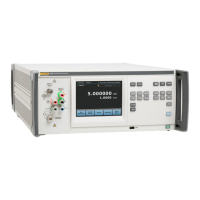5790B
Operators Manual
4-10
Guard Theory
The GUARD is an electrical shield around the sensitive analog circuitry, insulated
from chassis ground and the rest of the Product. The GUARD provides a low-
impedance path for common-mode noise and ground currents. The guard
reduces the chance of ground currents in the signal leads caused by powering
interconnected instruments from ac outlets at different ground potentials.
Guard Connection
The GUARD is internally connected to the INPUT 1 connector shell or the INPUT
2 LO binding post in this configuration. The GUARD binding post is disconnected
from the internal guard. This is the normal power-up state of the Product, and is
selected by pushing
so that the Guard indicator on the display is off.
Make most measurements with the external guard configuration. To prevent
errors due to common mode signals, especially at higher frequencies where the
guard becomes less effective, use the steps below. See Figure 4-1 for the test
lead connections to test a measuring instrument. See Figure 4-2 for the test lead
connections to test a source. Both illustrations show recommended ways to
connect to a source, and to connect to a source and other measuring device.
The guides in Figure 4-1 are identified by number:
1. Use short-signal connections to reduce the impedance in the signal return
path and to reduce the current due to capacitive loading.
2. Use relatively low-capacitance coaxial cable for connections to reduce the
return currents due to capacitive loading.
3. If attenuation is used, attenuate near the source.
4. Select the external Guard on the Product. Connect the GUARD of the
Product to the GUARD of the source and UUT. This will help prevent ground
signals from being capactivety coupled to the LO at the higher frequencies.
Note
Early versions of the 5790A (prior to S/N 6780031) may have a
different guard connection procedure than detailed in this manual.
To prevent inaccurate measurements, follow the guard connection
instructions in this manual.

